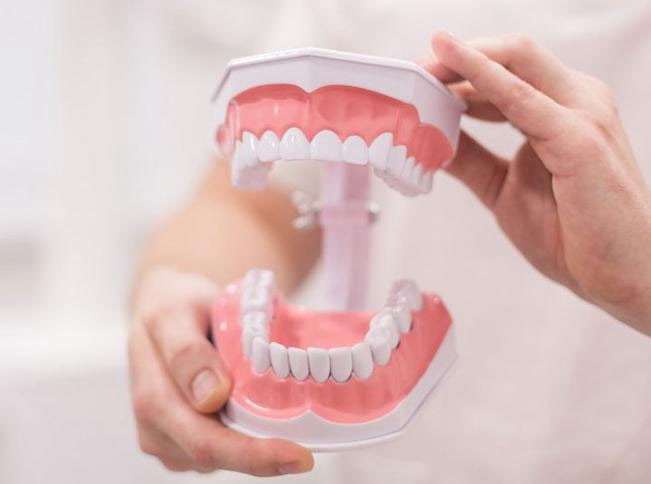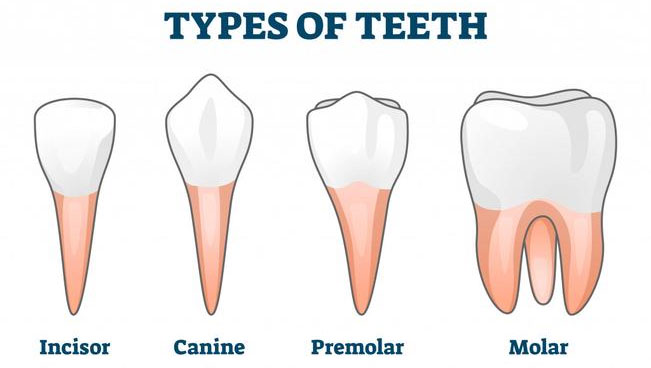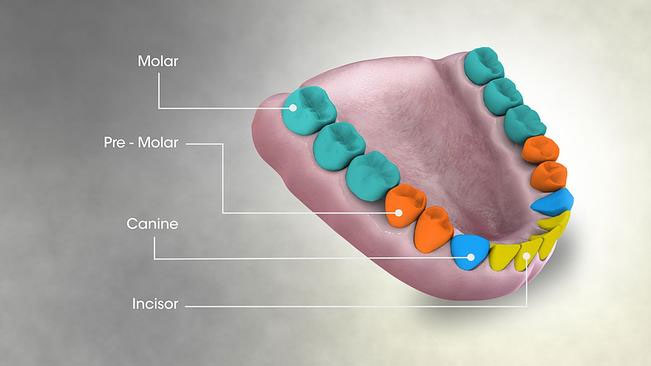Have you ever looked in the mirror and wondered why your teeth come in so many different shapes and sizes?
Teeth help us chew food, articulate sounds, and provide structure to our faces. Different types of teeth have distinct roles, which is why they vary in shape and size. Let’s explore each type of tooth and its function in this article.
Types of Teeth

The shape of each tooth gives them specialized functions when chewing food.
1. Incisors (Quantity: 8)
The teeth located at the front of the mouth are called incisors. There are 4 incisors on the upper jaw and 4 on the lower jaw, totaling 8 incisors. These teeth are flat and thin, shaped like chisels. Incisors help you cut and chew food into smaller pieces during the initial stages of chewing. They also assist in articulation and support the structure of the lips and face.
2. Canines (Quantity: 4)
Canines are sharp, pointed teeth located next to the incisors. There are 2 canines on the upper jaw and 2 on the lower jaw. They are long and pointed, essential for biting and tearing food, such as meat. This is why canines are more developed in carnivorous animals like lions and tigers… and in the fictional world, vampires!
3. Premolars (Quantity: 8)
Premolars are larger, flatter teeth that grow inward in the mouth, located behind the canines. These teeth have flat surfaces with many ridges. Premolars help chew and grind food, breaking it down into small enough pieces for swallowing. Adults typically have 8 premolars, with 4 in the upper jaw and 4 in the lower jaw. Young children do not have premolars; they emerge when children are about 10-12 years old, which is when they start to get their permanent teeth.
4. Molars (Quantity: 8 – 12)
Molars are the largest teeth in the mouth. They are large, with flat surfaces and ridges designed for chewing and grinding food. Adults have 12 permanent molars, 6 in the lower jaw and 6 in the upper jaw, while children have 8 primary molars.
The last molars to emerge are known as wisdom teeth, or third molars, typically appearing between the ages of 17 and 21. They are located at the back of the mouth, in the far corners. Some people do not have all 4 wisdom teeth, or they may remain impacted within the jawbone and never emerge.

Different types of teeth from left to right: incisors, canines, premolars, molars
Primary Teeth and Permanent Teeth
The number and type of teeth a person has will change with age. Generally, we have two sets of teeth in our lifetime: primary teeth, or baby teeth, and permanent teeth, or adult teeth.
Starting around 6 months of age, infants will develop their first two teeth, known as primary teeth or baby teeth. Additional primary teeth will emerge every 1-2 months until the child is 2 years old and has a complete set of primary teeth. Primary teeth are temporary.
As permanent teeth form in the bone beneath the primary teeth throughout childhood, the roots of the primary teeth will gradually be absorbed into the gums. This causes the primary teeth to loosen and fall out, making way for the permanent teeth to emerge. These permanent teeth are also referred to as adult teeth. Children typically begin losing teeth around age 6, and this process concludes around age 12.
Permanent teeth include incisors, canines, premolars, and molars. The primary set does not include premolars. The teeth that replace the primary molars are called first and second premolars. As the jawbone continues to grow throughout puberty, there will always be space for molars. The first permanent molars typically appear around age 6, while the second permanent molars appear at age 12.
The third permanent molars, or wisdom teeth, usually do not emerge until around ages 17-25, but sometimes they may never appear – they might remain hidden in the jaw or simply not exist. In total, adults have 32 permanent teeth, whereas we initially have only 20 primary teeth.

Permanent teeth set: yellow – incisors, blue – canines, orange – premolars, green – molars
Conclusion
The different types of teeth – incisors, canines, premolars, and molars – all have specialized and important roles, helping us chew and grind food for digestion. Teeth also assist in articulation and shape our facial structure. We have two sets of teeth in our lifetime – a primary set consisting of 20 teeth and a permanent set consisting of 32 teeth.


















































